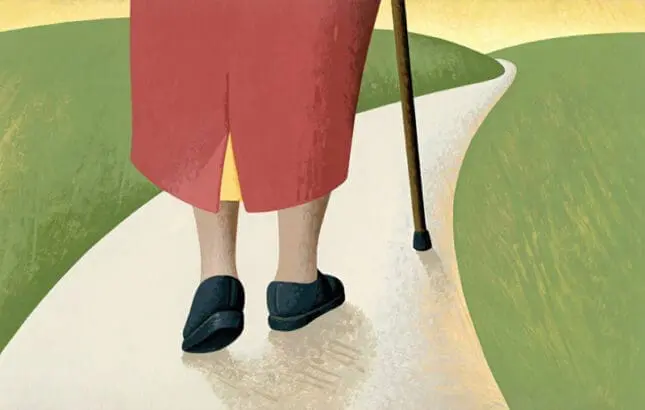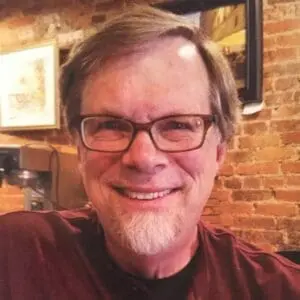Back in my western Pennsylvania hometown, I’m walking through the crowded showroom of a furniture store with my mother. Soon my older brother will join us, and together we’ll carefully wend our way through room after room in search of a bed, a dresser, a couch, and other odds and ends. My mother walks gingerly through the cluttered rooms as I follow closely behind, hoping she doesn’t lose her balance and fall into one of the dozen or more cushy recliners, all in a row. She stops here and there to rest, but there’s determination in her eyes. At age 94, she’s made a decision we’d never have thought possible two years earlier.
Back then, she was in and out of the local hospital so often that they could’ve installed a revolving door just for her. I was traveling back and forth from my home four hours away to provide whatever help I could to both my brother and mother, who, at the time, lived together. Usually, upon my arrival, she’d greet me with a warm, welcoming embrace. But on one such trip, I opened the front door to find her sitting listlessly in her wing chair, unable to get up. Her graying hair was disheveled, and she was still wearing her beige, cotton nightgown and nylon robe. She was weak (eating made her gag), having regular TIAs (transient ischemic accidents, or ministrokes), and suffering from congestive heart failure. I crossed the room, a fading grin on my face, and hugged her. Her arms were frail, and her back was delicate to the touch.
When she was admitted to the hospital that day she made it clear that she hoped the end was coming soon. She was tired of going back and forth between home and hospital, tired of never feeling well, tired of a life that didn’t seem to have anything more to offer. Making things worse, she was prescribed a combination of medicines that triggered a psychotic episode in which she was found wandering the hospital corridor, unsure of who or where she was. I vacillated between fury and worry, questioning the competence of almost everyone, calling her doctor, making a nuisance of myself at the nurses’ station, and repeatedly reaching out to the social-work office, which never responded.
The next day she reiterated her wish to die. Although she wasn’t afraid—her Christian faith gave her confidence in an afterlife where she’d be reunited with her family, friends, and my father—it was hard listening to her tell a physician that “there’s no point to living” and she was “ready to go.” Even so, I found myself thinking, Yeah, I get it. There’s nothing more for her to do in this life.
But several days later, much to her consternation, my mother hadn’t died. Rather, her health had improved, and she was discharged to an assisted living facility in a nearby town. Over the next three months, we sold the house, my brother found an apartment, and I settled into the Big Final Wait, where all of us linger when our parents reach a certain age.
The first time I went to the assisted living facility I remembered that it had been a psychiatric hospital in my youth. Its dark, weathered brick exterior still looked bleak. Although the interior had been remodeled, there was no denying that she was moving into what had been a hospital ward. On her floor, there was a long corridor with a nurse’s station at one end and a dining/activity room at the other. She had a room of her own, but shared a bathroom with a woman who rarely talked or got out of bed.
When my mother first arrived at “the place,” as she called it, her ministrokes increased for a while—which raised her hopes that the end might still be just around the corner. Then, almost without noticing, she began to adjust to her new residence. She enjoyed having her hair done regularly and wearing something other than hospital gowns. She started eating again and the TIAs stopped. She made friends with residents and staff.
Still sharp as a tack, she sometimes complained, half-jokingly, about having to live with a bunch of “old people.” Indeed, as her energy for life returned, she even took on a minister who was broadcasting his beliefs, uninvited, at every meal. When he attacked the notion of having a female president and then added that it would be “as bad as having a black president,” she got up from her chair and moved to the seat beside him, to challenge him on statements. After he fumbled and mumbled for a while, my mother, in her direct, firm way, told him he was being “ridiculous.” Then she got up quietly and went back to her seat.
Despite her moments of vigor, I felt my mother was in the winding-down phase of her life—a time when the end is right in front of you, but you have no idea how long it will take to get there. From the vantage point of my mid-60’s, and looking at her cohorts, it seemed to be a time when the present moment was a hodgepodge of medical regimens and institutional routines, a constant struggle with halting ambulation, and a daily battle with boredom and loneliness. You could try to retreat from the dismal present by receding into the past, exploring all that was and will never be again; but as for the future, what was the point? No need to plan for it seriously. After all, there’s nothing left to do. No more challenges, no more firsts, nothing to launch. At least that’s how I saw it.
Two years into her life at “the place,” I took her and my brother out for breakfast at Hazel’s, a favorite diner with the best breakfasts around. As we finished our eggs and sipped our coffee, our mother made a simple announcement: she wanted to move. I completely understood this. “The place” left much to be desired. In fact, I’d been researching other assisted living options for months. Before I could say anything, though, she went on to explain that she didn’t want to move to another assisted living facility—she wanted to move into an apartment. She wanted to set out on her own.
Taken aback, my brother and I fell silent for a long moment. I put the creamer down without adding any to my freshened coffee and folded my hands in front of me. As my mother placed her napkin across her plate, I saw that her face was calm but resolute. She was a very different mother from the one who couldn’t get out of her chair to greet me two and a half years earlier. Then it dawned on me: in all her life, she’d never lived alone before.
Although this wasn’t part of the explanation she offered (assisted living was far too expensive for what it offered her, there was always some drama among residents in the dining room, the food was awful, there was no one to build a relationship with, largely because most of the residents suffered from varying degrees of dementia), I felt that being on her own, taking her life into her own hands, was part of what made this decision so right—a first, at last. I felt proud of her, despite the anxiety her decision evoked in me. Can she handle her medications? What about cooking? What if she falls and no one is there? Still, I leaned forward on my elbows, glanced at my brother, and told my mother I thought it was a great idea.
That week, she placed her name on the waiting list for a rent-controlled apartment building back in our hometown and settled into what we were told would be a yearlong wait for an opening. Although my mother remained enthusiastic, calling me from time to time to share rumors that something might open up soon, a part of me wondered if, during such a long wait, the whole notion of moving might drift away. But just a few weeks later, as I was pulling into the parking lot of my daughter’s apartment building, my phone rang. I barely had a chance to say hi before my mother blurted, “I got the apartment!”—which is how, after the considerable mishegoss that accompanies satisfying government housing rules and regulations, I found myself at the furniture store where my brother and I were helping her buy everything she’d need to furnish her new digs.
Mind you, my mother comes from a long line of steady-as-she-goes German women—women who never acted on impulse. She was always the even hand, maintaining stability in our family, never veering off into uncharted territories, where dreams or adventures might tempt. So how did I square this with living on her own for the first time? At 94? Turns out audacity was built into her DNA, as well.
As I write this, she’s settling in and doing well, although if she has to plod through another phone menu just to speak to a real, live, flesh-and-blood person so she can get her bank statement or have her cable connected, there’ll be hell to pay. When I called her recently, she spent most of the conversation talking about people who’d dropped by, phone calls she’d received, plans she was making to meet with her “circle.” I said, “Sounds like you’re busy.”
Always one to downplay the obvious, she said, “A little, I suppose.”
“You ever feel lonely at all?” I asked.
“Not at all. I feel content,” she answered, a spark of light in her voice.
I hung up feeling amazed by her scrappy resilience and her willingness to take on what many would never consider doing at her age. At this point, rather than guiding me through the winding-down phase of life, she’s teaching me never to underestimate one’s own capacity for newness and beginnings.
She exemplifies what the Romantic poet John Keats called negative capability, which, put simply, is the ability to embrace uncertainty, even though it often means leaving behind the safety of knowing what will be. The biblical frame for this is “going out not knowing.” This takes faith, some courage, and a large dose of chutzpah. Not to mention a lot of love for this life, no matter how wrinkled it’s gotten.
Illustration © Adam Niklewicz
David Seaburn
David Seaburn was an Assistant Professor of Psychiatry and Family Medicine at the University of Rochester Medical Center for nearly 20 years, where he was Director of the Family Therapy Training Program (Psychiatry) and Coordinator of the Psychosocial Medicine Rotation (Family Medicine). He’s the co-author of Family-oriented Primary Care: A Manual for Medical Providers (1990) and Models of Collaboration: A Guide for Mental Health Professionals Working with Health Care Practitioners (1996) and the author of nine novels, including Darkness is as Light (2005), Pumpkin Hill (2007), Charlie No Face (2011), Chimney Bluffs (2012), More More Time (2015), Parrot Talk (2017), Gavin Goode (2019), Broken Pieces of God (2021), and Give Me Shelter (2022). He was a founding member of the Collaborative Family Healthcare Association and its former Treasurer. In 2005, he left the Medical Center to become Director of the Family Support Center in the Spencerport Central School District, a free counseling center for students and their families.













